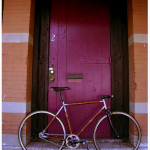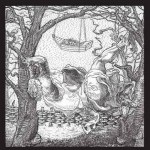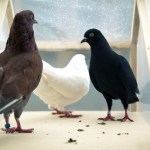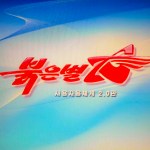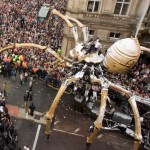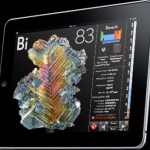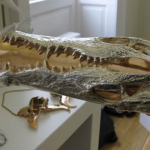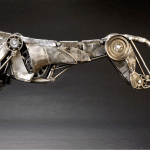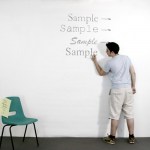design
Ok, maybe we're not quite there yet - but Panda Bicycles is making bikes out of bamboo. These partly renewable, lightweight bikes are striking, to say the least - though they're not cheap. But if you really want to make a statement with your bike, this is one way to go. . .
Thanks to reader Linda for the link!
This is the clever label for Chateau Skulls, a grenache blend from south Australia. Wikipedia sez,
The label is an original artwork by István Orosz (b. 24 October 1951; Kecskemét) Hungarian painter, printmaker, graphic designer and animated film director, is known for his mathematically inspired works, impossible objects, optical illusions, double-meaning images and anamorphoses. The geometric art of István Orosz, with forced perspectives and optical illusions, has been compared to works by M. C. Escher."
I blogged about Istvan Orosz earlier, in this post on anamorphosis.
Der Mensch als Industriepalast [Man as Industrial Palace] from Henning Lederer on Vimeo.
So awesome! Fritz Kahn's poster reimagined as an animation by Henning Lederer. Via Bora.
Somebody in charge of pulling flickr illustrations for Wired's website has a good eye - they used this photo by Stephen Hampshire. A quick visit to flickr, and it turns out the photo is of Hampshire's homemade version of a DIY project originally described by Neil Fraser: a wooden cube brain map/puzzle. Fraser summarized his creation thus:
Last month I took a left-right MRI scan, reconstructed it, and rerendered top-bottom and front-back scans. It was interesting to manipulate the data and extract information which while previously present, was not previously visible. Another method to…
A German home improvement company turns an old apartment building into a modern wonder cabinet, as part of an ad campaign: first they covered the facade with a flock of shoes (Dr. Isis must have been their muse) and then they installed concept art throughout the whole thing (some of it nuts, and some of it pretty remarkable). They won a 2009 Mobius Award for their work. Check it out:
I think we'd all like to have the room with the giant air mattress/bubble in it. Mmmmmmm, sleeping on a giant bubble.
Now that's bioephemera: my friend Rhett sent me a link to the work of Fulvio Bonavia, who created a series of eighteen photographs of food reimagined as haute couture. My favorite? The glassy-eyed sardine-link belt. See all eighteen images, and his other work, at his website.
Via Coute Que Coute.
I'm a little late in posting about the recent work of Tuur Van Balen, a Belgian designer who uses art and design to explore the boundaries between people and technology. His work has explored synthetic biology and biotechnology for years, and I first was introduced to his work through news of his Urban Biogeography project. A recent focus in synthetic biology has been the design of simple biosensors, strains of bacteria or yeast that can sense an environmental pollutant and produce a measurable output such as color change. Thanks to the work of several very creative iGEM teams, the Registry…
The North Korean government has made an operating system called "Red Star."
Despite the fact that very few North Koreans have a computer, let alone Internet access, Red Star is designed to provide a safe operating environment in line with North Korean political philosophy of "juche," or self-reliance (as well as, admittedly, monitor user activity).
The Red Star O.S. takes fifteen minutes to install, uses a popular Korean folk song as its start-up music and features a calendar which starts counting time from the birth of Kim Il-sung, making 2010 the year 99. Amazingly, it's Linux-based, with…
Many people in synthetic biology, including myself and much of my lab, are working on using biology to make things more efficiently, renewably, and sustainably. Being able to make plastic replacing biomaterials, chemicals, medicines, and fuels in living cells from renewable resources (especially in photosynthetic organisms that need only sunlight and water) will undoubtedly decrease our dependence on fossil fuels and with a lot of work in policy and process and infrastructure engineering may one day become truly sustainable. It's difficult to not notice, however, how unsustainable most…
I have no idea of the source on this one - anybody know who made it? This artist has created a similar model, but the inside's padded as seating, so it probably wouldn't work as well as a human hamster wheel.
Via
Anthropologie's new From the Deep collection features cobalt blue tentacles reaching over the edge of a dinner plate while an octopus broods on the salad plate.
There are even suckers on the teacup handles!
You can Life Aquatic it up quirky-collage-style with the coordinating dishes featuring collaged fish, stripes, and disproportionately tiny ships, but I'm a purist: I WANT a set of those three tentacular pieces. If I were only getting married so this could be my pattern. . . sigh.
From the Deep collection at Anthropologie.
Reader Jake alerts me that Wired has just put up a gallery of robot spiders (and spider-like critters). If you've always wanted to be creeped out by a 40-foot robot Shelob, be my guest!
Something I ran across by accident, while perusing our latest copy of Issues in Science and Technology: currently, the National Academies are sponsoring a Visual Culture and Evolution Online Symposium. It runs through Wednesday. What that means, apparently, is their panelists discuss the intersection of design, art, and culture with evolutionary biology concepts (sexual selection, genetics, adaptation, etc.) at a blog set up for the purpose.
The blog is basic (generic template), and a bit confusing. What seems to be happening is that panelists' ongoing contributions are folded into the posts…
So the word among my friends is that the iPad, which, as Stephen Fry noted, may be the closest thing humanity has yet produced to a Hitchhiker's Guide to the Galaxy, might just be worth buying -- if only as a stunningly cool toy and not, alas, the tablet many of us wanted. For example, I give you TouchPress' ebook The Elements for iPad, by Theodore Grey:
As the first really new ebook developed from the ground up for iPad, The Elements beautifully shows off the capabilities of this lovely device. It is impossile to describe in words the experience of seeing and almost feeling over 500…
A fun poster by editorial artist Harry Campbell (you've no doubt seen his work in the NYT and elsewhere). Love the cut-aways and perspective changes - it reminds me of a children's book.
Style Bubble has some snapshots of luxe skull- and carapace-inspired jewelry by Dominic Jones. You've just got to love a crocodile skull vambrace!
See more snaps at Style Bubble.
Via Haute Macabre - you musn't miss their other recent post on Dominic Jones' work for Vice Magazine. Here's a teaser:
Because of my recent interest in autonomous, biologically inspired robots, my friend Tami sent me some fascinating links about designs and concepts for future flesh eating robots.
From New Scientist, furniture that captures vermin and uses the biomass to power fuel cells that run small electronics:
From Wired, Human corpse powered robots being developed by the Defense Department:
From the file marked "Evidently, many scientists have never seen even one scary sci-fi movie": The Defense Department is funding research into battlefield robots that power themselves by eating human corpses. What…
I don't think I've posted yet about Andrew Chase's graceful articulated metal sculptures. His cheetah is particularly stunning.
Click the image to watch it run!
Chase's mechanical sculptures have way more personality than metal should. The soulful eyes of his elephants and giraffes could reflect some futuristic world in which extinct flesh-and-blood animals have been (inadequately) replaced with patchwork gestures at nature. Or perhaps they look lonely because they're intimidated by the flesh-and-blood inspirations of which they are ingenious, but dead, replicas.
Robot Timmy Recharging…
You may have heard from Slashdot that the University of Wisconsin is switching from Arial, a sans-serif font, to Century Gothic, a serif** font that uses 30% less ink, for default printing. The university hopes to save ink, which is both thrifty and eco-friendly. But you may not have seen this art project by Matt Robinson and Tom Wrigglesworth: they used ballpoint pens to scribble large-scale test versions of various fonts on a wall, and the ink level afterward was an analog readout for which font uses more ink. Ingenious!
Word to the nitpicky: while there's no rule that a sans-serif font…
Cellularity is a new project by James King, a speculative designer working on biotechnology and interaction design. The project focuses on the potential future of smart pharmaceuticals, drug molecules surrounded by membranes that over time as technology advances may come to more and more closely resemble actually living things. He proposes a cellularity scale from totally non-living to really alive artificial cells. This quantification of "aliveness" in a way is something that may need to be done if some of the proposals of synthetic biology come to fruition. When does a membrane surrounding…
